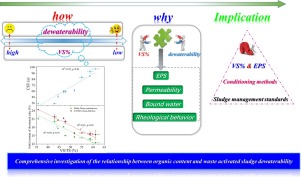当前位置:
X-MOL 学术
›
J. Hazard. Mater.
›
论文详情
Our official English website, www.x-mol.net, welcomes your
feedback! (Note: you will need to create a separate account there.)
Comprehensive investigation of the relationship between organic content and waste activated sludge dewaterability.
Journal of Hazardous Materials ( IF 12.2 ) Pub Date : 2020-03-28 , DOI: 10.1016/j.jhazmat.2020.122547 Hou-Feng Wang 1 , Hao Hu 2 , Hua-Jie Wang 3 , Ya-Nan Bai 4 , Xiao-Fei Shen 5 , Wei Zhang 4 , Raymond Jianxiong Zeng 1
Journal of Hazardous Materials ( IF 12.2 ) Pub Date : 2020-03-28 , DOI: 10.1016/j.jhazmat.2020.122547 Hou-Feng Wang 1 , Hao Hu 2 , Hua-Jie Wang 3 , Ya-Nan Bai 4 , Xiao-Fei Shen 5 , Wei Zhang 4 , Raymond Jianxiong Zeng 1
Affiliation

|
The relationship between sludge organic fraction and its dewaterability is well known in practice. However, the formal study to reveal the underlying reason is limited. To improve understanding of the nature of organic content on sludge dewatering process, this study systematically evaluated the effects of sludge organic content on its dewaterability and revealed the underlying mechanism. Analysis of 10 waste activated sludge (WAS) samples with varying organic contents showed that capillary suction time (CST) increased linearly from 34.90 ± 0.10 s to 104.90 ± 0.30 s (R2 = 0.92, p < 0.01), whereas the solid content of centrifuge cake decreased from 21.23 %±0.45 % to 12.52 %±0.14 % (R2 = 0.89, p < 0.01) when organic fractionincreased from 35.72 % to 61.11 %. These results first confirmed that WAS dewatering performance was negatively correlated to its organic content. Then, the underlying mechanism was revealed by studying the basic physicochemical properties of WAS with various organic content. The results showed that sludge with a higher organic content generally had greater extracellular polymeric substances (EPS) content, lower density and higher negative zeta potential, which hinder the aggregation and flocculation of floc particles. These properties endow the WAS with a higher organic content generally possessed more bound water content, small pores, poorer fluidity, and stronger network strength. These characteristics can hamper the separation of water from sludge cake during dewatering. Based on which, this study discussed the potential of organic fraction as a surrogate of EPS for evaluating WAS dewaterability and indicated the organic fraction can be a useful and strong indicator of WAS dewaterability.
中文翻译:

综合研究有机物含量与废物活性污泥脱水能力之间的关系。
在实践中,污泥有机部分与其脱水能力之间的关系是众所周知的。但是,正式研究揭示其根本原因是有限的。为了更好地了解污泥脱水过程中有机物含量的性质,本研究系统地评估了污泥有机物含量对其脱水能力的影响,并揭示了其潜在机理。对10种有机含量不同的废料活性污泥(WAS)样品的分析表明,毛细抽吸时间(CST)从34.90±0.10 s线性增加至104.90±0.30 s(R2 = 0.92,p <0.01),而离心机的固体含量当有机物分数从35.72%增加到61.11%时,滤饼从21.23%±0.45%降低到12.52%±0.14%(R2 = 0.89,p <0.01)。这些结果首先证实了WAS的脱水性能与其有机含量呈负相关。然后,通过研究各种有机物含量的WAS的基本理化性质,揭示其潜在机理。结果表明,有机物含量较高的污泥通常具有较高的细胞外聚合物质(EPS)含量,较低的密度和较高的zeta负电位,这会阻碍絮凝物颗粒的聚集和絮凝。这些特性使WAS的有机含量更高,通常具有更多的束缚水含量,小孔,较差的流动性和更强的网络强度。这些特性会阻碍脱水过程中污泥饼中水的分离。基于此,
更新日期:2020-03-28
中文翻译:

综合研究有机物含量与废物活性污泥脱水能力之间的关系。
在实践中,污泥有机部分与其脱水能力之间的关系是众所周知的。但是,正式研究揭示其根本原因是有限的。为了更好地了解污泥脱水过程中有机物含量的性质,本研究系统地评估了污泥有机物含量对其脱水能力的影响,并揭示了其潜在机理。对10种有机含量不同的废料活性污泥(WAS)样品的分析表明,毛细抽吸时间(CST)从34.90±0.10 s线性增加至104.90±0.30 s(R2 = 0.92,p <0.01),而离心机的固体含量当有机物分数从35.72%增加到61.11%时,滤饼从21.23%±0.45%降低到12.52%±0.14%(R2 = 0.89,p <0.01)。这些结果首先证实了WAS的脱水性能与其有机含量呈负相关。然后,通过研究各种有机物含量的WAS的基本理化性质,揭示其潜在机理。结果表明,有机物含量较高的污泥通常具有较高的细胞外聚合物质(EPS)含量,较低的密度和较高的zeta负电位,这会阻碍絮凝物颗粒的聚集和絮凝。这些特性使WAS的有机含量更高,通常具有更多的束缚水含量,小孔,较差的流动性和更强的网络强度。这些特性会阻碍脱水过程中污泥饼中水的分离。基于此,











































 京公网安备 11010802027423号
京公网安备 11010802027423号